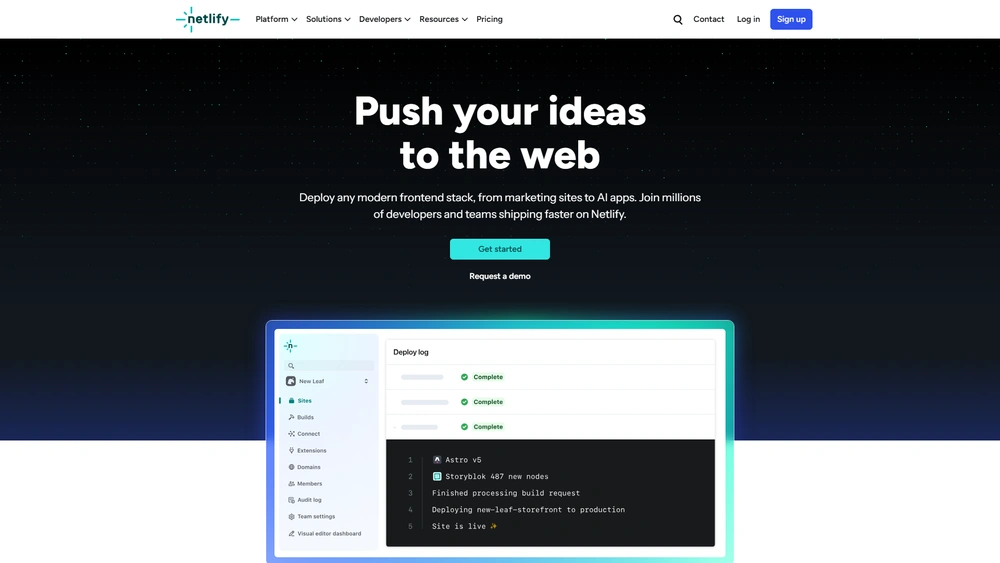Netlify Overview & 2025 Industry Position
Netlify has transformed from its Jamstack roots into a powerful platform for front-end teams and AI-powered applications. As of 2025, it stands at the crossroads of performance, automation, and global scalability — uniquely positioned to support modern enterprise-grade websites and micro frontends at scale. With a refined DevOps abstraction and an industry-leading edge network, Netlify enables hyper-agile deployments and resilient experiences for developers and users alike.
From Launch to 2025: Netlify’s Journey
Founded in 2014 by Mathias Biilmann and Christian Bach, Netlify introduced the Jamstack movement as a new web architecture philosophy. In 2017, it launched Functions, followed by integrations with Git workflows. By 2020, it had introduced Build Plugins and acquired Stackbit and OneGraph to deepen integrations and team workflows.
Key milestones:
- 2015: Early Jamstack pioneer with automated builds from Git.
- 2017: Launch of Netlify Functions enabled serverless development.
- 2021: Acquired OneGraph, introducing GraphQL-based integrations.
- 2023: Rolled out Netlify Connect (data unification) and edge compute upgrades.
- 2024: AI deployment support with auto-scaling LLM endpoints.
In 2025, Netlify focuses on low-latency personalization, AI/LLM deployment support, and developer-centric DX tooling, making it the preferred platform for composable architecture and collaborative front-end workflows.

Netlify Key Features
Netlify’s platform centralizes the core components of shipping, running, and scaling sites and frontend apps. The key features include:
- Composable Web Apps: Connect APIs, microservices, and frameworks seamlessly
- Netlify Functions: Serverless compute close to the edge
- Edge Functions: Real-time content rendering & personalization
- Netlify Connect: Unified data access layer across content sources
- Environment Branching: Preview deploys from any Git branch instantly
- Global CDN: Asset distribution with low latency and automated scaling
- Workflow Automation: Git-based continuous deployment with CI/CD tooling
Workflow & UX
Netlify has refined the developer experience to streamline project setup, iteration, and environment sharing. Whether deploying statically generated Jamstack sites or modern SSR applications, the UX prioritizes automation and clarity. Key UI innovations include:
- One-click Git integrations (GitHub, GitLab, Bitbucket)
- Live deployment previews with feedback comments
- Built-in role management for team collaboration
- Deploy logs and analytics visible per commit or branch
Pro Tip: Use Netlify’s Deploy Previews to involve marketing, design, or QA earlier in your process without staging bottlenecks.
Netlify Pricing Analysis & Value Metrics
As of July 2025, Netlify pricing includes both self-service tiers and custom enterprise plans:
| Plan | Monthly Price | Key Inclusions |
|---|---|---|
| Starter | $0 | Deploy previews, CI/CD, 125k function calls/month, 100GB bandwidth |
| Pro | $19/user | Team access, 1M function calls, 1TB bandwidth, edge functions |
| Business | $99/user | Advanced logs, SSO, SOC2 compliance, 5M function calls |
| Enterprise | Custom | Uptime SLAs, custom CDNs, global scaling, dedicated support |
Value summary: The Starter tier is powerful for solo projects, while Business or Enterprise fit mid-to-large orgs needing compliance, observability, and deep framework support.
Competitive Landscape
| Platform | Strengths | Ideal For |
|---|---|---|
| Vercel | Excellent Next.js support, great for frontend teams | React-heavy stacks |
| Cloudflare Pages | Ultra-low latency edge, CDN-native platform | Performance-critical apps |
| Render | Flexible full-stack hosting, PostgreSQL & background jobs | Fullstack devs |
| Netlify enterprise | Composability, Edge + CI/CD fusion, AI workflows | Teams building microsites, LLM apps, ecosystem-integrated sites |
High-Impact Use Cases
Netlify shines in composable architectures, JAMstack-first initiatives, and edge-personalized web experiences. Top implementation types include:
- Marketing landing pages with CMS integration
- Product documentation portals with API fetch layers
- AI-driven tools with LLM endpoints via Edge Functions
- eCommerce storefronts with headless CMS & PIM tooling
- Developer hubs or SaaS admin panels tied to GraphQL backends
Netlify Integrations & Ecosystem
Netlify supports dozens of native integrations, with deep hooks into CI tools, payment gateways, content APIs, eCommerce, and CMS providers. Key partnerships include:
- GitHub, GitLab, Bitbucket – Version control & CI
- Stripe, Shopify, BigCommerce – eCommerce stacks
- Contentful, Sanity, WordPress – Headless CMS options
- Datadog, Bugsnag – Observability and error monitoring
- Slack, Discord, Teams – Deployment alerts and team workflows
Pros & Cons
- Pros: Robust developer workflows, instant previews, secure by design, auto-scaling serverless functions, enterprise support tiers
- Cons: Learning curve for teams new to CI/CD or frontend deployments; edge usage limits on lower tiers; pricing scales with user count
Final Thoughts
Netlify continues to push the innovation curve in the web development world. With hybrid rendering support, live branch previews, and support for AI-scale applications, it’s built for teams shipping fast, globally, and collaboratively. While its feature abundance may overwhelm juniors or solo devs, its value for production-scale projects and digital teams is unmatched in 2025.
Netlify FAQ
Netlify is used to build, deploy, and manage modern web apps, static sites, and serverless APIs with automation and edge performance baked in.
Yes, Netlify supports SSR via frameworks like Next.js and Astro, and handles it through Edge Functions and serverless compute.
With CDN-level caching, composable APIs, and dedicated support options, Netlify handles enterprise use cases — including AI, eCommerce, and microsites — at global scale.
Yes, for most web app and content-based sites, Netlify provides hosting, CI/CD, edge compute, and scalability in a single platform.
Yes, Netlify offers a generous free plan with deploy previews, bandwidth, and basic serverless compute for personal or student projects.

